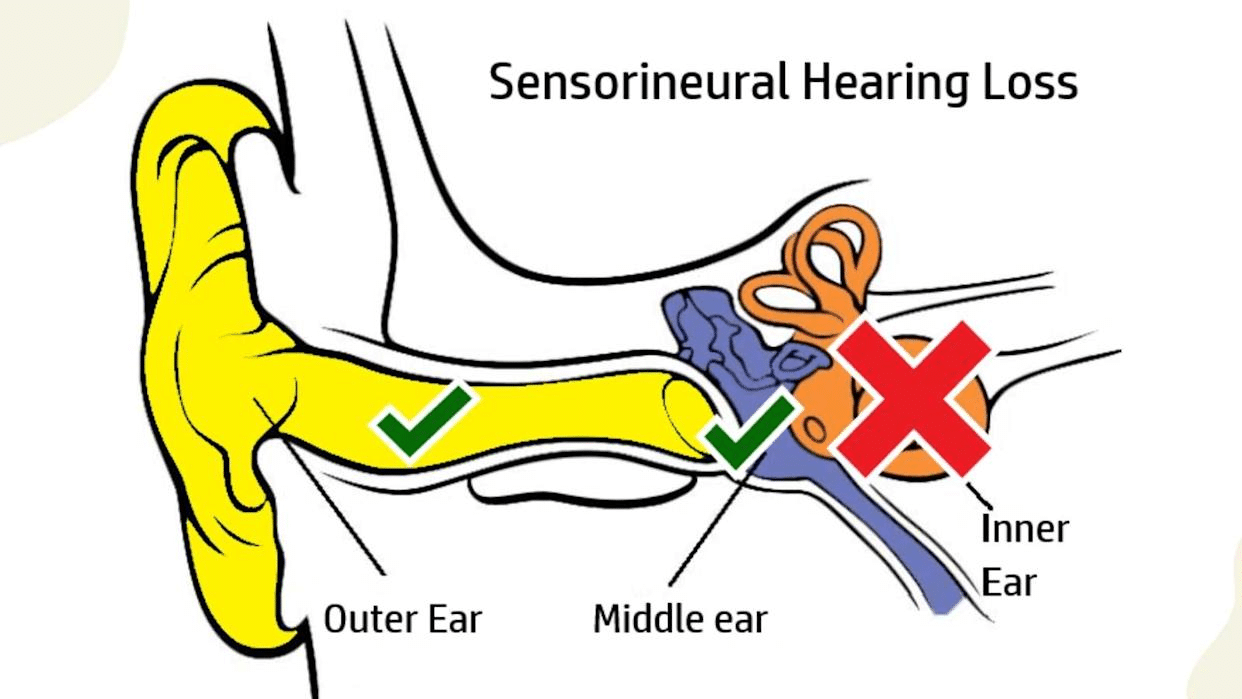Sensorineural listening to loss takes place whilst there is damage to the inner ear or the nerve that connects the ear to the mind. This form of hearing loss makes it difficult to listen to faint sounds and apprehend speech clearly. It’s far the most commonplace type of everlasting listening to loss.
Listening is a crucial part of day by day lifestyles. When a person starts off evolved to lose it, simple conversations or taking part in track can emerge as difficult. Early detection and care could make a big difference. Knowing the symptoms helps people take action sooner.
This newsletter explains what sensorineural listening to loss is, its main reasons, and common symptoms. It additionally covers extraordinary treatment options and beneficial approaches to manage listening to fitness effectively.
Types of Sensorineural Hearing Loss
Congenital listening to Loss
Some humans are born with sensorineural hearing loss. It is able to occur due to genetic elements or headaches for the duration of being pregnant. Early analysis could be very crucial for speech and language improvement.
received listening to Loss
This type develops later in life. it can be because of loud noise, aging, infections, or certain medicines. signs normally seem gradually and may worsen over the years.
unexpected listening to Loss
Every so often, listening can drop abruptly in a single ear. That is uncommon however serious. On the spot scientific attention is wanted to improve probabilities of recovery.
modern hearing Loss
This kind worsens slowly over months or years. Growing older is the most commonplace purpose. regular check-ups can assist control it effectively.
Protecting Your Hearing
When listening to higher levels, reduce the listening duration or limit it to 1 hour a day to avoid damaging the ears. For those who are unsure whether they’re experiencing early hearing changes or simply need clearer sound support, resources like Audien Hearing offer helpful comparisons between everyday earbuds and hearing aids, making it easier to understand which option provides the right level of assistance for daily listening needs.
If you aren’t positive about your hearing, you could get help. sources like Audien hearing examine earbuds and listening to aids. They show which choice offers the first-rate assist for each day’s listening. information that allows you to pick what’s proper to your ears.
How Common is Sensorineural Hearing Loss?

Sensorineural listening to loss is quite commonplace globally. It affects human beings of all ages, from kids to older adults. The hazard increases with age and publicity to loud sounds. Many human beings might not comprehend they have it before everything.
- approximately 1 in 8 people inside the U.S. has a few hearing loss.
- Age-related listening to loss could be very unusual after 60.
- Loud noise publicity can cause hearing loss at any age.
- Early detection facilitates prevent similar damage.
cognizance and ordinary listening to check-ups are vital. simple steps can protect your hearing and improve quality of life.
Symptoms and Causes
Sensorineural listening to loss can begin slowly or unexpectedly. Humans may also have trouble hearing smooth sounds or understanding speech. Ringing within the ears (tinnitus) is also commonplace. Every now and then, balance troubles may additionally appear.
The causes of sensorineural listening to loss vary. It could be genetic, age-related, or caused by loud noise, infections, or positive drug treatments. The desk below indicates common causes and symptoms:
| Causes | Symptoms |
|---|---|
| ageing (Presbycusis) | hassle listening to excessive-pitched sounds |
| Loud noise exposure | Ringing in ears, muffled listening to |
| Genetics/Inherited factors | hearing loss from beginning or youth |
| Infections (e.g., meningitis) | sudden hearing loss, dizziness |
| Ototoxic medications | slow hearing loss, tinnitus |
information these symptoms early facilitates in seeking proper remedy. Normal listening to exams is advocated for each person in danger.
Diagnosis and Tests for Sensorineural Hearing Loss
To diagnose sensorineural hearing loss, a doctor first asks about your symptoms and clinical history. They have a look at your ears and take a look at how nicely you listen to extraordinary sounds. Early trying out facilitates in handling listening to loss successfully.
Common tests include:
- natural Tone Audiometry: Measures the softest sounds you may pay attention to.
- Speech Audiometry: assessments how well you apprehend speech.
- Tympanometry: assessments center ear feature.
- Otoacoustic Emissions (OAE): Evaluates internal ear hair mobile characteristics.
- Auditory Brainstem reaction (ABR): assessments nerve alerts from ear to mind.
Those tests help decide the type and severity of listening to loss. Medical doctors can then propose exceptional treatment or hearing support.
FAQs
1. Can sensorineural hearing loss be cured?
maximum cases can not be completely cured, however remedies like hearing aids or implants can assist.
2. Is it caused by loud noise?
Yes, prolonged exposure to loud noise is not an unusual cause.
3. Can kids have sensorineural hearing loss?
sure, it may be present from start or expand in early adolescence.
4. How is it one of a kind from others listening to loss?
It entails harm to the internal ear or auditory nerve, now not the outer or center ear.
5. Can it worsen over the years?
yes, specifically if due to ageing or persisted exposure to loud sounds.
Final Words
Sensorineural hearing loss is commonplace however often viable. Early detection and proper care could make a huge distinction. the use of hearing aids, implants, or protective measures enhances daily life.
normally take a look at-ups and fending off loud noise are important. know-how the symptoms and reasons allowed in taking movement early. With the proper support, human beings with listening to loss can lead a complete and active lifestyle.
